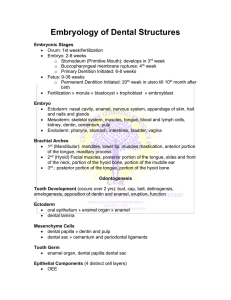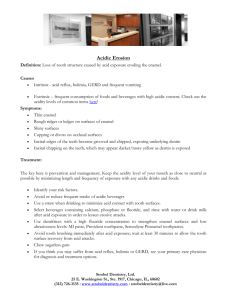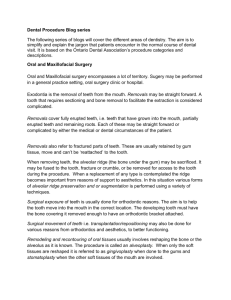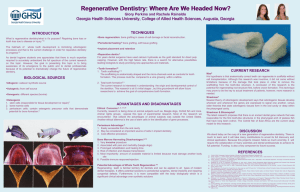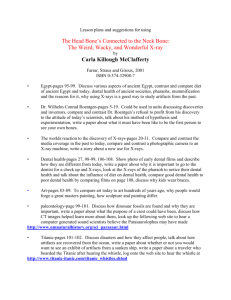File
advertisement
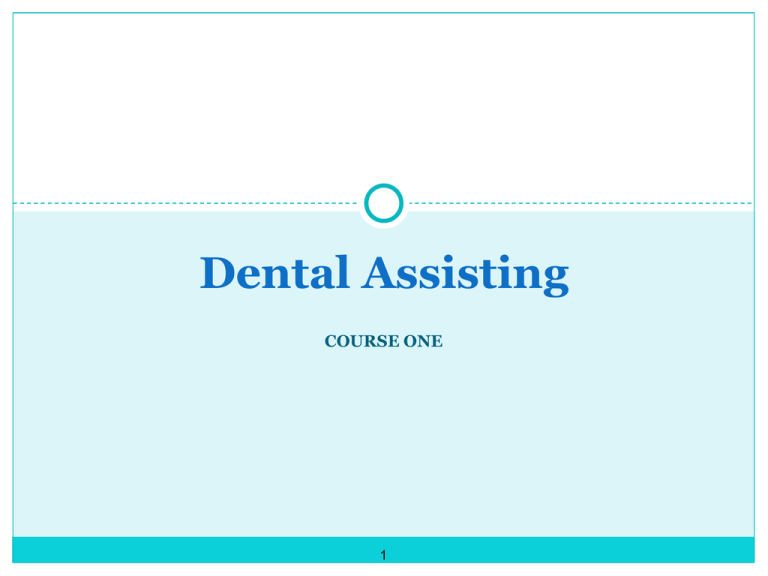
Dental Assisting COURSE ONE 1 History of Dentistry False teeth used to be made of wood or ivory Often painful dental treatments were done by "guzzling some vodka" Wilhelmina Conrad Roentgen discovered radiographs, X-rays in 1895 C.Edmund Kells - New Orleans dentist was the first to employ a dental assistant in 1885 1948 the Certifying Board of American Dental Assistants Association was established 1950 1-2 year programs for dental assisting education 2 Professional Dental Assistant Professionalism is an attitude that is apparent in everything we do and say Must demonstrate patience and compassion when dealing with patients and other team members The dental assistant has many roles - chair side, expanded functions, administrative, etc. After completing the necessary requirements in an institution - clinical and didactics, the certified dental assistant must write and be successful in the dental assisting national board exam 3 The Dental Healthcare Team Dentist - has received an undergraduate degree, successfully completed dental school and may it may not specialize (such as Endodontist, Orthodontist, etc.). Licensed with their association Dental hygienist - successfully completed a clinical and didactics course, taken the national dental hygiene exam and performed the clinical exam (if graduated from a non-accredited school). Needs to be registered with an association Dental receptionist - may not may not have completed a specialized dental reception course Dental laboratory technician - usually does not work in the dental office but in a laboratory setting. Performs tasks given by a dentist. They would have passed their written exam and be apart of their association 4 Dental Ethics REVIEW THE CODE OF ETHICS AT THE FOLLOWING LINK: http://www.cdha.ca/pdfs/Profession/Resources/CDHA_Co de_of_Ethics_public.pdf 5 Ethical Dilemmas Identify alternatives - what are the likely outcomes of each choice? Determine the professional implications - what should and should not be done professionally with each alternative Rank the alternatives - choose the best alternative Choose a course of action - make a judgment call after following all steps and you should feel confident in your decision 6 Dentistry and the Law Criminal law - crimes against society Civil law - involves crimes against individuals Felony - major crime Misdemeanor - lesser offense that may result in fines or suspension of license Infraction - minor offense (not paying registration fees on time) 7 Types of Supervision Direct - the dentist must be physically present in the office, he or she will review the work delegated to the dental assistant before and after completion General - (indirect) the dentist has authorized and delegated specific procedures to a qualified dental assistant. An example would be exposing radiographs that have been prescribed 8 Duty of Care/Standard of Care Legal concept that provides boundaries Examples include - a patient with HIV CANNOT be refused treatment Abandonment - the dentist must give the patient written notification to discontinue treatment to allow the patient to find another dentist in good time 9 Acts of Omission and Commission Malpractice - is professional negligence and the two types are listed: 1. Act of omission - is failure for a professional to perform an act that would have been performed, such as failure to diagnose bone loss because radiographs are not taken 2. Act of commission - an act that a professional would not perform, such as administrating too much anesthetic to a child that would result in an overdose 10 Informed Consent The patient must understand and be capable to understand informed consent Implied consent - the patient is agreeing to treatments by sitting in the dental chair no knowing what their appointment is for Written consent - BEST form of consent! Informed refusal - the patient has this right and can refuse all or a portion of treatment at any time but the dentist may require written refusal for documentation (refusing radiogram as an example) Minors - the parent(s) or guardian must give consent for minors 11 Patient Records Financial records ARE NOT included in the patients chart It's better to document "too much" Entries must be made in ink and anything that needs to be crossed out, has to be done using a single line through the word(s), dated, and initialed The dentist owns all records and charts but the patient has the right to access this information at all times 12 Child Abuse The dental assistant has the professional responsibility to report any suspected acts of child abuse to a child protection agency in your area or to the police. The dental assistant CANNOT be sued if suspected child abuse is indeed false, this is called 'immunity' 13 General Anatomy Anatomical position - the body stands erect with face forward, feet together, arms at the sides, and palms forward Midsagittal plane - median/midline plane, vertical plane that divides the body into equal left and right halves Horizontal plane - transverse plane, divides the body into superior (upper) and inferior (lower) portions Frontal plane - coronal plane, any vertical plane at right angles to the midsagittal plane that divides the body into anterior (front) and posterior (back) portions Distal - furthest from the point and mesial is closest to the point Dorsal - on the back and ventral is on the front 14 General Physiology Periosteum - first layer of the bone 'surrounds the bone'. Responsible for the life of the bone and very necessary for nutrition, repair, etc. This is anchored to the bone by Sharpey's Fibers Osteoblasts - 'building bone' responsible in bone formation Osteoclasts - 'cancels bone' destroys the bone Compact bone - cortical bone, hard and strong. This forms the outer layer Cancellous bone - spongy bone, found inside the bone. Trabeculae are found inside that form a honeycomb pattern where the spaces are filled with bone marrow Bone marrow - produces white blood cells to fight infection, red blood cells or carry oxygen, or platelets to help stop bleeding 15 Blood Vessels Arteries - large blood vessels that carry blood away from the heart to all regions Capillaries - microscopic vessels that connect the arterial and venous system Veins - low pressure connecting system to return waste filled blood to the heart. Veins have thinner walls and are less elastic 16 Blood and Blood Cells Plasma - transports nutrients, hormones and waste. Plasma is 91% water and the rest consists of proteins RBC - erythrocytes, contain the protein hemoglobin and transports oxygen. When erythrocytes are no longer useful they are destroyed by macrophages WBC - leukocytes, fighting disease. The five major groups of leukocytes are: 1. Basophils - have many functions 2. Eosinophils - increase with allergic reactions 3. Lymphocytes - immune process 4. Monocytes act as macrophages and dispose of dead and dying cells as well as debris 5. Neutrophils - fight disease by engulfing germs 6. Thrombocytes also known as platelets, are very small. Clots the blood 17 Rh Factor Rh factor is an additional antigen present on the surface of the red blood cells of some individuals. Rh positive - contains the factor Rh negative - does not contain the factor Anti-Rh antibodies are not naturally found but do develop if exposed to the factor Example: an Rh negative mother who gives birth to an Rh positive baby will not have a blood reaction with the first pregnancy, but after mixing of blood during delivery, the mother will develop anti-Rh antibodies in her serum. This condition can cause death of the fetus. Immediately after delivery of the Rh positive babies, Rh negative mothers are given an injection of anti-Rh gamma globin to prevent the development of anti-Rh antibodies 18 Integumentary System The skin is the body's first line of defense against disease as it helps regulate body temperature, barrier, excretes liquids and salts, etc. Epidermis - outer layer of the skin. No blood supply. As new cells are pushed to the surface, older cells die and are sloughed off Dermis - thick connective tissue layer that gives bulk to the skin. Many free nerve endings and receptors. With age, the connective tissue becomes less elasticized and wrinkles develop 19 Glands Sebaceous glands - all areas except the palms of the hands and soles of the feet. Oil glands. Sudoriferous glands - all over the body and provide heat regulation by secreting sweat. Apocrine sweat glands - largest glands and are found under the arms, around nipples and genital region. Body odor. 20 Hard and Soft Palates Formed by the primary palate and secondary palate. Begins in the 5th week of prenatal development Fusion usually begins from the anterior during the 9th week. Palate completed during the 12th week within the fetal period. 1. Formation of the primary palate 2. Formation of the secondary palate 3. Fusion of the palate Any disruption results in a cleft lip or palate 21 Tooth Development When the embryo is 5-6 weeks old, the first sign of tooth development are found in the mandibular anterior region 7th week - all primary teeth are developed and development of permanent teeth begin At birth there are normally 44 teeth in various stages of development. Enamel formation is underway in the primary dentition and just beginning on the permanent first molars 22 Tooth Development 23 24 Life Cycle of the Tooth The growth periods: the bud, cap, and bell stages Crown - covered by enamel, and each root has dentin covered by cementum Anatomic crown - portion of the tooth covered with enamel Clinical crown - portion of the tooth that is visible in the mouth Root - covered with cementum. Bifurcation means two roots and trifurcation means three roots. Enamel - hardest material in the body. Formed by ameloblasts consisting of 96-99% inorganic matter. Hydroxyapatite which is primarily calcium, is the most abundant mineral component. 25 26 Enamel Composed of millions of calcified enamel prisms, known as enamel rods. These extend from the surface of the tooth to the DEJ Hunter-Schreger bands - microscopic light and dark bands are caused by enamel prisms changing direction Striae of Retzius - growth rings. The shock of birth is known as the neonatal line Enamel tufts - start at the DEJ and may extend to the inner third of the enamel. Hypocalcified or uncalcified ends of groups of enamel prisms 27 Enamel Continued Enamel lamellae are thin structures that extend from the enamel surface towards the DEJ. Organic material primarily Enamel spindles are the ends of odontoblasts that extend across the DEJ a short distance into enamel 28 Dentin Extends across the entire length of the tooth, covered by enamel on the crown and by cementum on the root Normally a light yellow but can darken with age Mineralized tissue that is harder than bone and cementum but not as hard as enamel 70% inorganic material and 30% organic Dentin is formed by odontoblasts and these line the walls of the pulp cavity to form and repair dentin Dentinal tubules – canals in dentin that contaisn the dentinal fiber 29 Dentin Continued Primary dentin – forms prior to eruption, forms the bulk of the tooth Secondary dentin – begins formation after eruption and continues at a very slow rate throughout life of the tooth. This results in the pulp chamber becoming narrow with age Tertiary dentin – reparative dentin, formed in response to trauma on the wall of the pulp chamber. This can also occur in response to attrition. 30 Cementum Covers the root of the tooth, it overlies dentin and joins the enamel at the CEJ Primary function is to anchor the tooth to the bony socket with attachment fibers within the periodontium Yellow, and lighter in color than dentin Formed by cementoblasts and DOES NOT resorb and form again Capable of some repair through new layers 31 Cementum Primary cementum – acellular cementum is formed outward from the cementodentinal junction for the full length of the root Secondary cementum – cellular cementum, after the tooth has reached functional occlusion, continues to form on the apical half of the root 32 Pulp The pulp and within it the pulp chamber, which follows the contours of the exterior surface of the tooth The pulp is large in primary teeth but becomes smaller in permanent teeth and with age 33 Pulp Continued Coronal pulp – within the crown portion Radicular pulp – apically located, also called root pulp Apical foramen – the radicular portion of the pulp in each root is continuous with the tissues of the periapical area via an apical foramen. In young teeth this is not fully formed, and has a wide opening. Secondary dentin eventually decreases the pulp chamber and apical foramen Blood vessels and nerves enter the pulp through the apical foramen. 34 Pulp Continued The pulp also contains connective tissue, which consists of cells, intercellular substance, and tissue fluid. Fibroblasts are cells responsible for the formation of the intercellular substance of the pulp. The nerve supply transmits and received pain stimuli. When the stimuli is weak, the response by the system is weak. When the stimulus is great, the reaction is stronger, and pain is present 35 Periodontium Supports the teeth in the alveolar bone Consists of cementum, alveolar bone, and periodontal ligaments Consists of the ‘attachment apparatus’ and the ‘gingival unit’ Attachment apparatus: cementum, alveolar process and periodontal ligaments Gingival unit: oral mucosa and the three main types are lining, masticatory, and specialized 36 Periodontium Alveolar process – osteoblasts form bone and osteoclasts resorb and remodel the bone Cortical bone – dense outer covering of the spongy bone that makes up the central part of the alveolar process. Denser in the mandible Alveolar crest – highest point of the alveolar ridge. In a healthy mouth, the distance between the CEJ and the alveolar crest are consistent but with periodontal disease it will start to flatten Alveolar socket – cavity within the alveolar process that surrounds the root of the tooth 37 Periodontium Alveolar socket continued – the bony projection separating one socket from another is called the interdental septum. The bone separating the roots of a multirooted tooth is called the interradicular septum Lamina dura – also known as the cribriform plate, is thin, compact bone that lines the alveolar socket. The nerves and blood vessels go through the tiny spaces. On a radiograph it appears as a thin white line around the root of the tooth 38 Periodontium Periodontal ligament – connects the cementum covering the root of the tooth with the alveolar bone of the socket wall At one end the fibers are embedded in the cementum and at the other end embedded in the bone The fiber groups support the tooth in its socket and allows the tooth to withstand the pressures and forces of mastication The fibroblasts of the PL helps with remodeling, as do the cementoblasts and osteoblasts (and clasts) 39 Periodontium The PL has three different types of fiber groups: The periodontal fiber groups that support the tooth in its socket (horizontal, oblique, apical and interradicular fibers) The transseptal fiber groups support the tooth in relation to the adjacent teeth Gingival fiber groups support the gingiva surrounding the tooth. Also has the dentogingival, alveologingival, circular and dentoperiosteal fibers. 40 Periodontal Fiber Groups 41 Gingival Unit Oral mucosa is composed of stratified squamous epithelium. The three main types of oral mucosa in the oral cavity are lining, masticatory, and specialized mucosa Lining – covers the inside of cheeks, vestibule, lips, soft palate, and ventral of the tongue. Beneath the lining is the submucosa containing blood vessels and nerves. NOT attached to the bone. Is a bright red color. 42 Gingival Unit Masticatory mucosa – attached gingiva, hard palate, and dorsum of the tongue Light pink in color and keratinized. Lining mucosa IS not (previously mentioned in the last slide) No submucosa in the masticatory mucosa Withstands chewing and swallowing, tough. Specialized mucosa – the dorsal of the tongue has both masticatory and specialized mucosa in the form of the lingual papilla. 43

